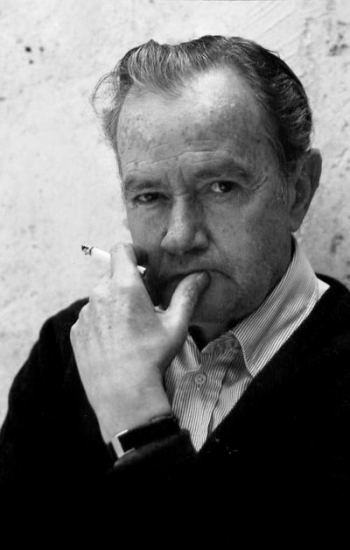Juan Rulfo (Juan Rulfo)

It was at the University that Juan Rulfo first began writing under the tutelage of a coworker, Efrén Hernández. In 1944, Rulfo had co-founded the literary journal Pan. Later, he was able to advance in his career and travel throughout Mexico as an immigration agent. In 1946, he started as a foreman for Goodrich Euzkadi, but his mild temperament led him to prefer working as a wholesale traveling sales agent. This obligated him to travel throughout all of southern Mexico, until he was fired in 1952 for asking for a radio for his company car. Rulfo obtained a fellowship at the Centro Mexicano de Escritores, supported by the Rockefeller Foundation. There, between 1952 and 1954, he was able to write two books. The first book was a collection of harshly realistic short stories, El Llano en llamas (1953). The stories centered on life in rural Mexico around the time of the Mexican Revolution and the Cristero War. Among the best-known stories are “¡Diles que no me maten!” (“Tell Them Not To Kill Me!”), a story about an old man, set to be executed, who is captured by order of a colonel, who happens to be the son of a man whom the condemned man had killed about forty years ago; and “No oyes ladrar los perros” (“Don’t You Hear the Dogs Barking(?)”), about a man carrying his estranged, adult, wounded son on his back to find a doctor.
The second book was Pedro Páramo (1955), a short novel about a man named Juan Preciado who travels to his recently deceased mother’s hometown, Comala, to find his father, only to come across a literal ghost town ─ populated, that is, by spectral figures. Initially, the novel met with cool critical reception and sold only two thousand copies during the first four years; later, however, the book became highly acclaimed. Páramo was a key influence for Latin American writers such as Gabriel García Márquez. Pedro Páramo has been translated into more than 30 languages, and the English version has sold more than a million copies in the United States. The book went through several changes in name. In two letters written in 1947 to his fiancée Clara Aparicio, he refers to the novel he was writing as Una estrella junto a la luna (A Star Next to the Moon), saying that it was causing him some trouble.[citation needed] During the last stages of writing, he wrote in journals that the title would be Los murmullos (The Murmurs). With the assistance of a grant from the Centro Mexicano de Escritores, Juan Rulfo was able to finish the book between 1953 and 1954; it was published in 1955. Between 1956 and 1958, Rulfo worked on a novella entitled El gallo de oro (es) (The Golden Cockerel), which was not published until 1980. A revised and corrected edition was issued posthumously in 2010. The Fundación Rulfo possesses fragments of two unfinished novels, La cordillera and Ozumacín. Juan Rulfo told interviewer Luis Harss that he had written and destroyed an earlier novel set in Mexico City. From 1954 to 1957, Rulfo collaborated with “La comisión del rio Papaloapan”, a government institution working on socioeconomic development of the settlements along the Papaloapan River. From 1962 until his death in 1986, he worked as editor for the National Institute for Indigenous People.
Born
- May, 16, 1917
- Mexico
- Sayula, Jalisco
Died
- January, 07, 1986
- Mexico City, Mexico
Other
- Cremated



